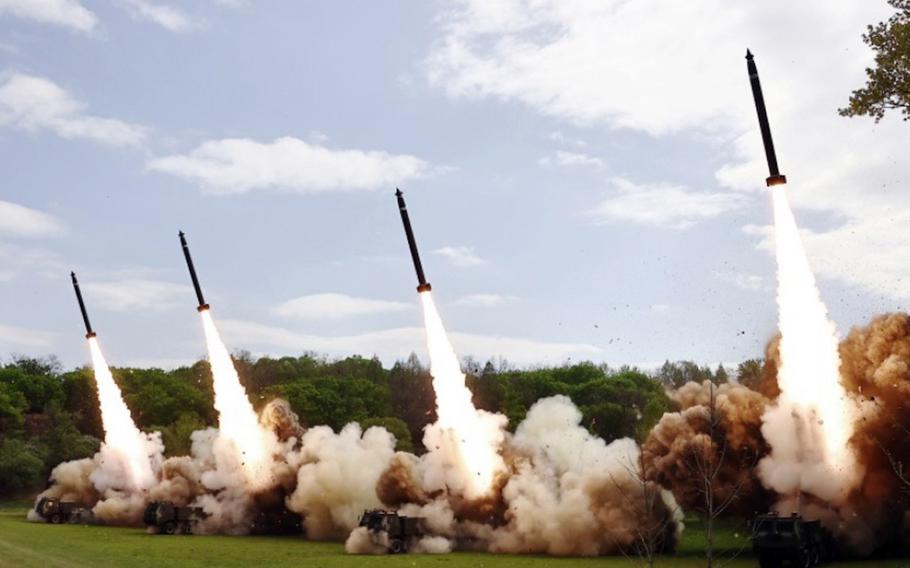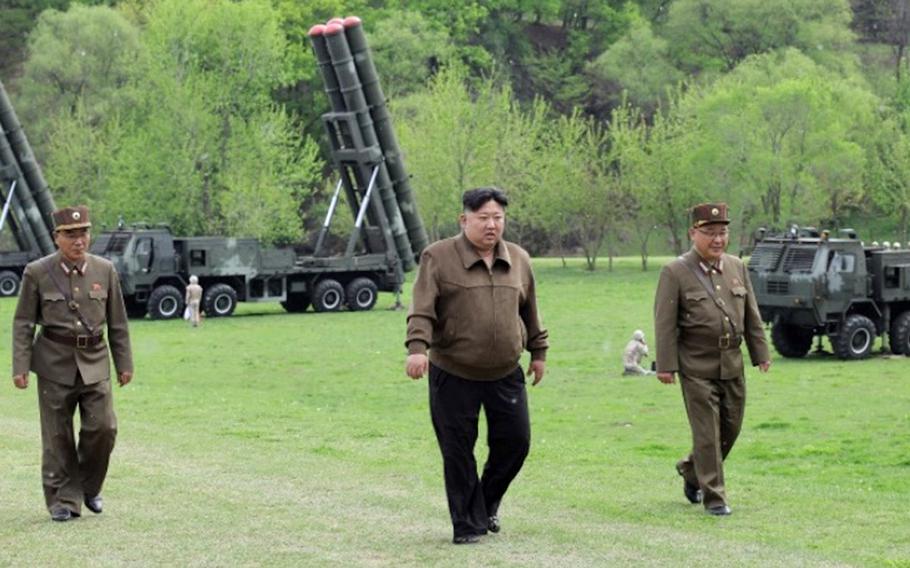
A image from the state-run Korean Central News Agency shows North Korea firing missiles from mobile launchers on April 22, 2024. (KCNA)
CAMP HUMPHREYS, South Korea — North Korea’s launch of several short-range ballistic missiles Monday was an exercise in counterattacking the United States and South Korea with nuclear warheads, according to the North’s state media.
North Korean leader Kim Jong Un presided over the drill that involved at least four mobile transporter-erector launchers, said a report and photos released Tuesday by the Korean Central News Agency.
The missiles flew approximately 190 miles before falling into the Sea of Japan, or East Sea, according to South Korea’s Joint Chiefs of Staff.
U.S. Indo-Pacific Command said the launches posed no immediate threat to U.S. personnel, territory or its allies, according to a statement Monday.
The North has yet to prove its missiles could be tipped with a nuclear warhead, South Korean Joint Chiefs of Staff spokesman Lee Seong-joon said Tuesday. Monday’s exercise may have served as cover for a delayed spy satellite launch, he added.
“If North Korea attempts to use nuclear weapons, it will be faced with an immediate … response from the South Korea-U.S. alliance,” Lee said during a news conference in Seoul.
KCNA’s report described the projectiles as 600 mm rockets that flew from an undisclosed site before hitting a simulated maritime target roughly 220 miles away, or within range of Seoul from Pyongyang.
North Korea frequently describes its missiles as rockets. KCNA previously reported 600 mm rockets were fired from multiple launchers during a drill March 18; South Korea and Japan called the weapons short-range ballistic missiles.
North Korea has been prohibited by the U.N. Security Council from firing ballistic missiles since 2006.
Monday’s launches were part of North Korea’s nuclear counterattack system and served as a “clear warning” against the U.S. and South Korea’s warmongering, KCNA said.
The report referred to the U.S. and South Korea’s largest annual air drill ending Friday and criticized the allies’ description of it being defensive in nature.
The two-week Korea Flying Training exercise includes 25 types of aircraft from both countries, according to 7th Air Force. On Friday, around 200 U.S. and South Korean special operations soldiers jumped out of U.S. C-17 Globemaster IIIs and U.S. and South Korean C-130 Hercules as part of the exercise.
KCNA’s report called the allies’ parachute drill a provocative “joint airborne infiltration drill” … to “remove a target.”
The U.S. condemned North Korea’s launches, which will be on Secretary of State Antony Blinken’s agenda when he travels to China, a North Korean ally since 1961, for talks with senior officials starting Wednesday, State Department spokesman Matthew Miller said during a news conference in Washington, D.C., on Monday.

An image from the state-run Korean Central News Agency shows North Korean leader Kim Jong Un overseeing a missile drill on April 22, 2024. (KCNA)